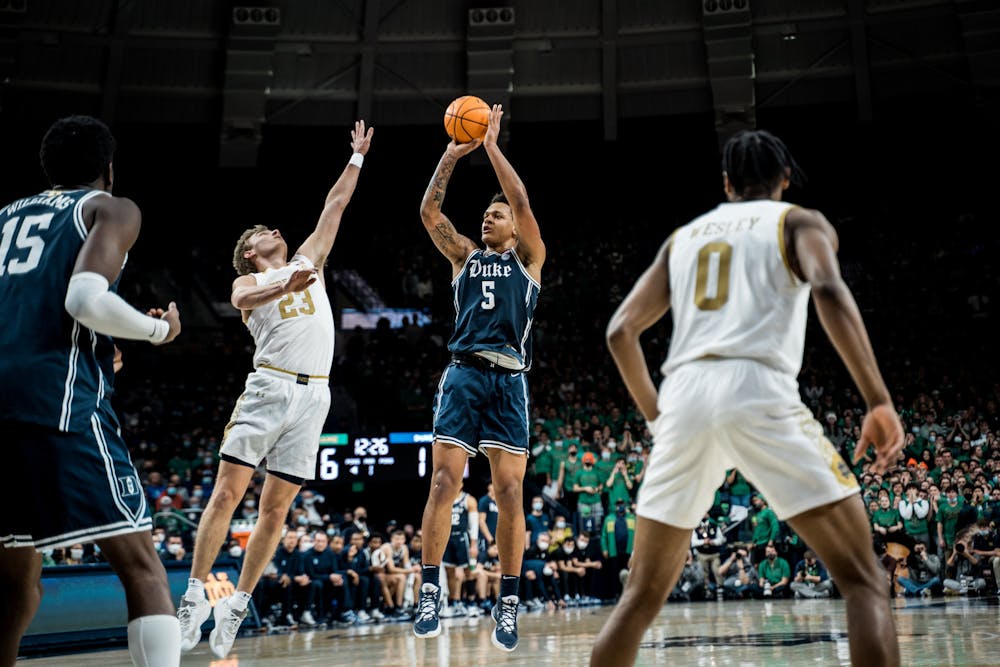CHESTNUT HILL, MASS.—Maybe you’ve had the experience, as I certainly have this season, of looking at the box score of a Duke game and thinking, “Wait, Paolo Banchero had a double-double? And led the team in points? When did that happen?”
Such is the luxury of watching the Blue Devils, as the continued dominance of a future NBA lottery pick is common enough to nearly fade into the background.
In the Blue Devils’ 72-61 win against Boston College Saturday, Banchero tallied 16 points, 14 rebounds and three assists. He led the Blue Devils in all categories and picked up his eighth double-double of the season, but it was the sort of quietly dominant performance that doesn’t scream, “Notice me!”
“He led us out there tonight. He was real strong in everything he did,” junior captain Wendell Moore Jr., who had 14 points of his own, said after the game.
This could be ridiculous to say, but Banchero has a particular way of flying under the radar and going unnoticed even as he chugs along from great statline to great statline. There is a natural comparison to be made between Banchero and other highly-touted Blue Devils—for example, Zion Williamson and RJ Barrett, drafted No. 1 and No. 3, respectively.
However, unlike Williamson or Barrett, Banchero usually eschews jaw-dropping dunks and volume shooting for layups in traffic and midrange jumpers. For a 6-foot-10, 250-pound 19-year-old, Banchero is uniquely sneaky in the way he pads the stat sheet, so much so that he can get lost among the chaos of a game and still emerge with a double-double.
That is to say, get lost to viewers. Duke’s opponents have certainly noticed Banchero. Banchero draws double teams like no one else, and opposing coaches can’t help but marvel at his physicality and athleticism. He’s a matchup problem for basically every other player in the conference, and as a result draws 2.2 shooting fouls per game, good for sixth among all ACC players.
Looking back at his time in Conte Forum, Banchero frequently found himself swarmed by Eagles, a phenomenon I’m sure he’s used to by this point in the season. In these scenarios, Banchero often looks for the pass first, and sometimes he finds it and makes a play that could be counted as a hockey assist. Otherwise, he creates his own shot, maneuvering his body to put his back between his defender and the ball with quickness and awareness, then using either his size or finesse to drive to the basket or step out for a turnaround jumper, respectively.
“We ran our version of kind of iso for him, and he made strong drives every time. He might not have scored every time, but he made the right play,” Moore said.
In traffic is where Banchero most obviously shines, and where he's arguably at his best. The two traits that really set him apart from other players are his vision and his athleticism and they enhance his role: a paradigmatic jack of all trades. A Swiss Army knife.
He’s a good enough shooter to be trusted from any area of the court, but he’s not a sniper. Outside the paint, Banchero’s attempt rate is spread pretty evenly across the court, per CBB Analytics, and his averages from the left baseline, right elbow and right wing are all about 15% higher than the national average, but he’s below the national average from the right baseline, top of the key and left wing. All that evens out to a well-rounded shooting profile.
Meanwhile, his rebounding is much improved, averaging nearly 10 rebounds in conference, up 2.5 from nonconference play. This is the second highest mark in the ACC in that time, and has been very impactful for his team which struggled with rebounding through the first half of the season. Still, it’s not player-defining compared to the likes of North Carolina’s Armando Bacot or Kentucky’s Oscar Tschiebwe. His assist per game clip of 2.7 puts him in the 97th percentile of NCAA players at his position, per CBB Analytics, but then again, he’s a forward, a position not generally expected to bear much of the playmaking load. No one who watches him can deny the benefit he brings quarterbacking offense.
None of this is to say he’s mediocre or over-hyped. In fact, having such a diverse skill set makes Banchero a very rare and very valuable player. What it can answer, though, is why a dominant player can be a quiet one. The things he excels at—such as playmaking and driving to the basket—are more technical and less flashy, but they are more than enough to raise him above the crowd, and his overarching goodness at everything makes him one of the most formidable players in college basketball.
It also allows him to be the perfect focal point for this Duke team. As an amalgamation of diverse talents, the Blue Devils don’t need a flashy, show-stopping star; they need someone who can not only fit within, but maximize those talents, and Banchero’s do-it-all playing style fits that bill.
Against Boston College, Banchero’s willingness to grind in the paint, move the ball and operate under pressure let him lead his team past a sloppy opening five minutes to enter the second half with a lead. He collected 10 points and two assists in the opening frame and was mission-critical in generating the momentum to get the rest of the Blue Devils going. The Eagles brought energy and fight from the get-go, and it's not hard to imagine Duke falling into the trap of a tight game with an inferiorly talented team again without Banchero navigating it through the opening stretch.
“Paolo [Banchero] established himself early. When we needed him most, he came through,” Moore said.
Moving forward, whatever the Blue Devils accomplish will likely go through Banchero. And though what he does to facilitate that likely won’t end up on SportsCenter Top Ten, it will be uniquely Banchero and, if executed at the level he can execute, all Duke needs from him and more.
Get The Chronicle straight to your inbox
Signup for our weekly newsletter. Cancel at any time.

Sasha Richie is a Trinity senior and a sports managing editor of The Chronicle's 118th volume.

